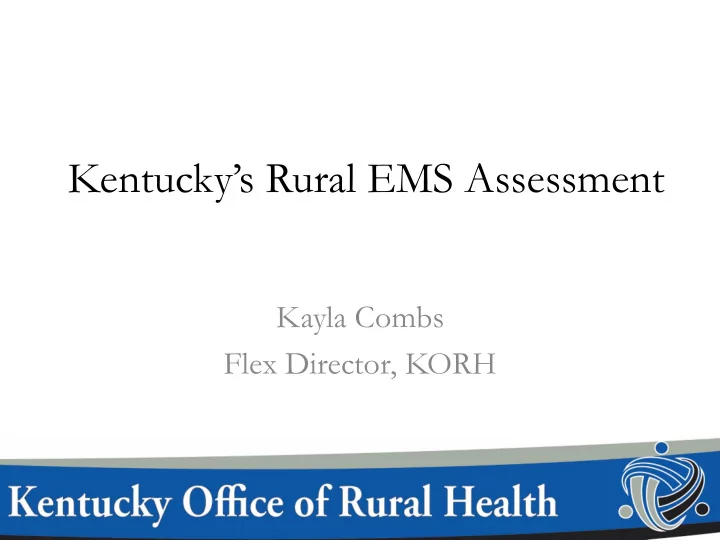

Kentucky’s Rural EMS Assessment Kayla Combs Flex Director, KORH
Why? • What are the issues Kentucky’s rural emergency services are facing? • Are they interested in or ready for Community Paramedicine? • What are other pressing needs? • Flex grant requirement
How? • Partnered with the Kentucky Board of EMS (KBEMS) to complete the assessment • Partnership of 3+ years • 129 Total respondents to the survey
Results Are you a public, private or volunteer service? 100 90 80 70 60 50 40 30 20 10 0 Public Private Volunteer
Results What are your staffing hours? 90 Other includes: 80 -12 and 24 depending 70 on full/part time 60 50 -All of the above 40 -24/16 30 -Varies on EMT 20 10 0 8 Hour Shifts 12 Hour Shifts 24 Hour Shifts Other
Results Do you feel that your service fulfills your staff's training and education needs? 120 100 80 60 40 20 0 Yes No
Results Do you feel you have adequate equipment for your service? 120 100 80 60 40 20 0 Yes No
Results Do you feel that you have adequate facilities? 120 100 80 60 40 20 0 Yes No
Results Does your service seek out public or private grants? 120 100 80 60 40 20 0 Yes No
Results Do you feel that you have adequate staff? 80 70 60 50 40 30 20 10 0 Yes No
Results Do you have staff retention issues? 80 70 60 50 40 30 20 10 0 Yes No
Results Is your service interested in Community Paramedicine? 100 90 80 70 60 50 40 30 20 10 0 Yes No
Results Do you have a relationship with your local hospital? 140 120 100 80 60 40 20 0 Yes No
Results • How could the relationship with your local hospital be improved? – Do not have a local hospital – Community Paramedicine would improve the working relationship significantly – Would love to help them out with outpatient and swing bed services – Could have a better relationship between crews and docs – Integrate hospitals and EMS, train them together, have hospital staff ride alongs, etc. – Lack of respect for EMS/They are not our boss – Meetings with hospital staff to see where we can improve – Be understanding, regulations/cost may keep us from being able to transfer some patients (non-emergent) – Apply for grants together – Improve communication – Understanding the role/capabilities of EMS (“no way to fix bias”, “we are professionals, not just ambulance drivers”) – Partner with hospital to work on reducing readmissions – Positive relationship with the hospital – Some are hospital owned
Conclusion • Many services are ready and anxious to start community paramedicine projects • 4 Pilot Projects starting soon, 3 Urban, 1 Rural • LOTS of data will be collected to show effectiveness of the program to state legislature
Questions? Kayla Combs Kayla.combs2@uky.edu
Recommend
More recommend